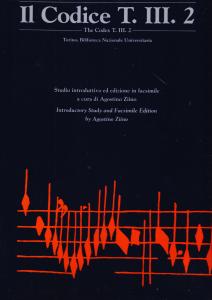Il Codice T.III.2 / The Codex T.III.2. Torino, Biblioteca Nazionale Universitaria
CODICE: ISBN 887096034X EAN 9788870960341
AUTORE/CURATORE/ARTISTA :
Studio introduttivo ed edizione in facsimile a cura di/Introductory study and facsimile edition by: Agostino Ziino
EDITORE/PRODUTTORE : LIM Libreria Musicale Italiana
COLLANA/SERIE : Ars Nova, 3
DISPONIBILITA': Disponibile
TITOLO/DENOMINAZIONE:
Il Codice T.III.2 / The Codex T.III.2. Torino, Biblioteca Nazionale Universitaria
PREZZO : EUR 100,00€
CODICE :
ISBN 887096034X
EAN 9788870960341
AUTORE/CURATORE/ARTISTA :
Studio introduttivo ed edizione in facsimile a cura di/Introductory study and facsimile edition by: Agostino Ziino
EDITORE/PRODUTTORE:
LIM Libreria Musicale Italiana
COLLANA/SERIE:
Ars Nova, 3
ANNO:
1994
DISPONIBILITA':
Disponibile
CARATTERISTICHE TECNICHE:
172 pagine/pages
52 tavv. colori/colour plates
Rilegato/Hardback
cm 23,5 x 34
NOTE:
Testi in italiano e inglese/English and Italian texts
DESCRIZIONE:
Commento dell'editore/Publisher's description:
Il volume raccoglie quindici bifogli provenienti da un codice finora sconosciuto agli studiosi e redatto presumibilmente nei primi anni del Quattrocento, fra la Savoia e Milano o Pavia. I nove fascicoli ricostruibili costituiscono una fonte di enorme importanza storica, che presenta caratteristiche inconsuete. Vi sono tramandate, nella tipica notazione della ars subtilior, quarantotto composizioni profane e liturgiche su testi francesi, italiani e latini, delle quali ben ventinove unica. Con una sola eccezione - "Frater Petrus de Sancto Seveno Ordinis Minorum Fratrum", l'altrimenti ignoto autore di uno dei brani - tutte le composizioni sono anonime, ma le concordanze con altri manoscritti consentono attribuzioni a Suzoy, Filippotto da Caserta, Antonello da Caserta, Antonio da Cividale e, soprattutto, Antonio Zacara da Teramo, per la cui conoscenza questa fonte si rivela particolarmente significativa.
Oltre all'elevato numero di Gloria tropati, rarissimi nella tradizione italiana, è notevole la contiguità di pezzi provenienti dal repertorio profano italiano e francese, a conferma del ruolo svolto da alcuni centri norditaliani non solo come tramite fra la tradizione compositiva locale e quella francese, ma anche come iniziatori di una nuova cultura musicale e di un nuovo stile, basati sulla reinterpretazione dei modelli d'oltralpe.
This volume consists of the fifteen surviving bifolios of a musical codex drawn up presumably in the early years of the fifteenth century in an area between Savoy and Milan or Pavia. With nine parts that can be reconstructed, this important source presents elements of outstanding historical interest. It is written in the typical notation of the Ars Subtilior and includes forty-eight religious and secular pieces on French, Italian and Latin texts, twenty-nine of which are not recorded elsewhere. With a single exception - "Frater Petrus de Sancto Seveno Ordinis Minorum Fratrum", the otherwise unknown composer of one of the compositions - all the pieces are anonymous, though concordances with other manuscripts enable us to make attributions to Suzoy, Filippotto da Caserta, Antonello da Cividale and, above all, Antonio Zacara da Teramo (for the knowledge of whose work the source is of particular value). Apart from a number of troped Glorias (very rare in the Italian tradition), what is remarkable is to find secular Italian and French pieces side by side in this way. This confirms that many north Italian centres not only acted as intermediaries between local and French compositional traditions, but also promoted a new musical culture and style based on models from beyond the Alps.
GENERE: Libri ,Monografie ,



